Why I Will Never Fly American Airlines Again :: At Least Not After Next Tuesday…
Posted on January 15, 2019
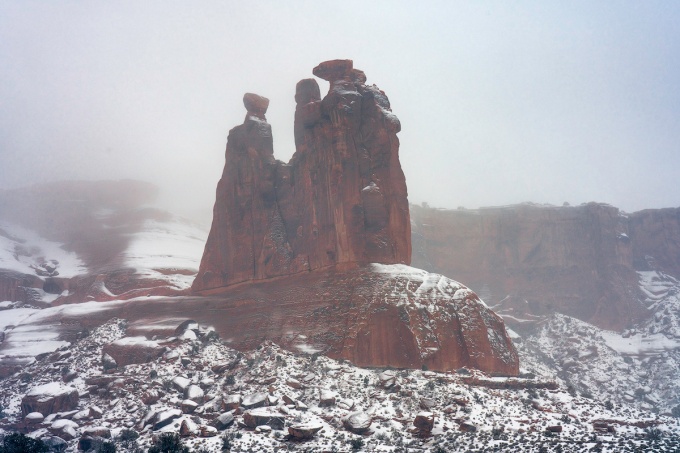
The Three Gossips, Arches National Park, Utah.
Sony a7R3, Sony 24-105mm, f/11, 1.6 sec., ISO 200
For the past 24 hours, American Airlines have done their best to make my life a living hell.
I was telling this story to a nice man named Robert at the Grand Junction Dollar Rental Car counter and his jaw dropped. He told me that he had been in the travel business all his life and never heard anything quite like this.
It’s not the story I am going to relay to you that is upsetting (hey – things happen when you travel) but it was the lack of customer support from American Airlines side once these following circumstances occurred.
If you got a few minutes, here is my tale that started yesterday (Monday) at San Jose International Airport.
First, the backstory
I was scheduled to fly Delta this Thursday from San Jose to Salt Lake City and finally on to Grand Junction, Colorado. From there it is about a 1 hour and 45 minute drive to Moab, Utah, where I will be hosting my Annual Arches/Canyonlands Photo Workshop.
Because the kiddies in Washington DC (known as Trumpy, Nancy and Chucky) keep fighting over the proverbial Popsicle on the playground (better known as the Border Wall that is keeping the government shut down), I had to have my travel agent switch my flights to a Monday departure so I could check on the condition of alternate locations in the Moab area should the parks remain closed.
It’s not the story I am going to relay to you that is upsetting (hey – things happen when you travel) but it was the lack of customer support from American Airlines side once these following circumstances occurred.
One hour after she made the switch (from Delta to American) I was notified by Austena, a longtime friend and contact in Moab who handles our hotels, that a local group paid the Utah Department of Transportation to plow the park roads – yes – it has been snowing out here and the parks are a winter wonderland! The parks reopened to the public this past Saturday.
And Now For The Rest Of The Story…
Too late to switch again and I stayed the course of departing Monday. My new American Airlines flight was set to depart San Jose International at 4:08pm. At 3:45pm came the first announcement that a switch had to be changed-out that controlled the airflow in the plane and it should take no more than 5 minutes. I had 48 minutes from touchdown to make my connecting flight.
Well 5 minutes turned into 95 minutes and of course, I missed my flight (along with 16 others). We were assured by the flight attendants that American Airline personnel in Phoenix had been notified and would be at the gate to greet us with updates on all of our connectors. I was a step ahead and was on the in-flight WiFi checking the American App. Alas, as we were taxiing to the gate, my connecting flight was departing – no way were they going to wait for us poor souls on board. How dare we even think they could hold the plane for 10 minutes!
OK – stuff happens and fortunately I calculated the time of the flight and pretty much knew that I was not making that connecting flight. I called my wife Beri from the plane in San Jose and asked if she could call my travel agent Linda (who has been booking my travel for the past 30 years) and told her the first flight out to Grand Junction from Phoenix today was 1:15pm. There were only 4 seats remaining and I wanted to be sure I had one.
Because the kiddies in Washington DC (known as Trumpy, Nancy and Chucky) keep fighting over the proverbial Popsicle on the playground (better known as the Border Wall that is keeping the government shut down), I had to have my travel agent switch my flights to a Monday departure so I could check on the condition of alternate locations in the Moab area should the parks remain closed.
Now we get to the gate in Phoenix Sky Harbor Airport and alas, the only person waiting for us was a janitor who could not speak English. He could however point the way to the American Airlines Service Center (I’m sure he has had plenty of practice). A strategic ploy by American Airlines to save money? Perhaps! Damn, these guys are good…
Now Is Where The Follies Really Begin!
Knowing that 16 of us were going to miss our connectors (along with another AA flight out of San Francisco – that also had a mechanical I’d later find out), American took bold action and stationed two agents – yes I said two! American Airlines was on the case and they were sparing no expense to help their stranded passengers.
I was in the front of the line and waited 20 minutes while the agents kibitzed with other passengers. When I finally got to the counter, I quickly realized the two agents had no idea that our plane was late due to a mechanical issue.
My friendly agent reassured me that I was on the 1:15pm flight (today – thank you Linda) and when I asked if they could switch me to another airline that was going out earlier I was told and emphatic NO. Well there goes a day’s worth of work.
Then the agent told me how sorry she was and that I would be staying at the Tempe Sheraton at no charge! Wow – what an airline. Then she looked me in the eye and said, “Mr. Smith, have you eaten dinner yet?” When I told her no, I was starving, she replied, “Then you go over to the Sheraton and have a nice dinner on us.” Of course I had visions of a juicy steak in my mind.
Knowing that 16 of us were going to miss our connectors (along with another AA flight out of San Francisco – that also had a mechanical I’d later find out), American took bold action and stationed two agents – yes I said two! American Airlines was on the case and they were sparing no expense to help their stranded passengers.
She then proceeded to hand me a meal voucher for $12 DOLLARS! I looked at it and said kindly, “Well this will pay for a beer and a bag of peanuts but where is the dinner voucher?” To which she replied with a smile, “That is your dinner Mr. Smith!” Serious, did she think it was 1975? Had I somehow flown through a time-warp and been transported back to the days of my youth? I looked around and saw no bell-bottom jeans, no long-haired hippies and wondered. I then asked meekly if she could ante up any more vouchers and I was given a dismissive look. How dare I be so bold and obtuse to even consider such a request!
When that got me nowhere, I asked if she could print my Boarding Pass for my new flight. When she did, I had been dropped to boarding group 5. I had paid for Priority Boarding in San Jose (Groups 1-4). She then told me that just covered me to Phoenix. I told her no, it guaranteed both flights – and showed her my Boarding Pass for my long-since departed flight to Grand Junction.
Now here is where the story actually gets funny… She told me, “Mr Smith, you will have to take that up with American Airlines.” I took a step back and glanced up at the big sign above here head: AMERICAN AIRLINES SERVICE CENTER. I told her calmly, “Mam, I think I am talking to American Airlines.” She then assured me that this was not something she could handle and I would have to call American Airlines. I said, can’t you call? to which she replied – “NO – NEXT.”
I said wait a minute, what about my bag? She asked incredulously, “Oh, do you need that?” I said yes, it has medicine in it that I need. She told me it could take up to 45 minutes for the bag to make it to the carousel. Thankfully it only took 30 minutes and I thought, well, things are trending in the right direction… (I was later told by my shuttle driver it normally takes three hours for American bags to arrive). Gee, my run of bad luck is really behind me now – onward driver to the Sheraton and my $12 dollar steak dinner!
Stay with me now – it only gets better…
With my hotel and meal voucher proudly in-hand, I marched confidently outside and waited for the Sheraton Shuttle. After 20 minutes, a small minivan with the words Tempe Airport Sheraton stenciled on the side arrived. There were four of us waiting (well actually more) but only four could get into the shuttle, er, I mean minivan.
Now here is where the story actually gets funny… She told me, “Mr Smith, you will have to take that up with American Airlines.” I took a step back and glanced up at the big sign above here head: AMERICAN AIRLINES SERVICE CENTER. I told her calmly, mam, I think I am talking to American Airlines. She then ensured me this was not something she could handle and I would have to call American Airlines. I said, can’t you call? to which she replied – “NO – NEXT.”
We made it to the hotel and I was checked-in and was actually given a breakfast voucher by a kind desk clerk. I then proceeded to have my steak dinner, and I asked the waiter if it was the $12 dollar steak? He looked at me incredulously and I said, “Never mind, long day.” The bartender laughed when I showed him my measly voucher and said, “Man, the airlines send us passengers all the time, and American is the cheapest of them all when it comes to vouchers.”
Fast-forward to this morning. I awoke, grabbed a cup of coffee, showered and proceeded to call American Airlines. “We’re sorry, we are experiencing unusually high call volume and we will call you back in 12-17 minutes.” Gee, I wonder why?
Thirty minutes later I finally received a call-back where I was again told once again by the cheerful agent that there was nothing American Airlines could do regarding my Priority Boarding, even though they could see that I paid for it. She even went as far as to tell me that she wished I would have called earlier as she had just come from as staff meetings where these types of issues are discussed. Damn my poor timing! How dare I sleep in…
I said, “I need to talk to a supervisor.” I was put on hold for 12 minutes when finally the same agent picked the phone back up and said, “The best we can recommend is to go back to the airport and try at the American Airlines ticket counter when you check in.”
We made it to the hotel and I was checked-in and was actually given a breakfast voucher by a kind desk clerk. I then proceeded to have my steak dinner, and I asked the waiter if it was the $12 dollar steak? He looked at me incredulously and I said, “Never mind, long day.” The bartender laughed when I showed him my measly voucher and said, “Man, the airlines send us passengers all the time, and American is the cheapest of them all when it comes to vouchers.”
OK I thought. So I grabbed my breakfast voucher and walked out to breakfast. I sat down and the waiter came over, saw the voucher, and told me, “That voucher is no longer valid.” I asked, “Why would it not be valid, your staff gave it to me when I came in last night?” To which he replied, “That voucher is only good up to 10am.” I looked at my watch – 10:08am.
He had walked away and was in a heated discussion with another woman from my flight who was also being denied breakfast. I asked once more, “I want to talk to a supervisor.” Fortunately the supervisor arrived and told the waiter to take our vouchers, then get rid of the food. Wow – another bullet dodged!
SERIOUS NOTE: I know it is the law to throw food out, but what a crime when we have so many homeless. Come on Don, snap out of it, get into the real world man. It’s dog eat dog out there – haven’t you learned that yet?
It’s Time To Start Day Two… It Can Only Get Better- Right?
Now it’s time to go back to Sky Harbor to get checked into my flight. I decided to use the Priority line because, well, I PAID FOR PRIORITY, but I guess in American Airlines world that also had expired. Are you seeing a trend here? I spoke to gate agent who agreed I should not be recharged for a bag that I had already paid for (wow -what a breath of fresh air) but my bag magically went from 49lbs. in San Jose to 51lbs. in Phoenix. I told you these guys were good!
Thus, I needed to pay an overweight bag fee. I calmly reassured her that I did not sneak out past curfew to go on a shopping spree in beautiful Tempe during the middle of the night. Honest coach, I was sound asleep.
I spoke to gate agent who agreed I should not be recharged for a bag that I had already paid for (wow -what a breath of fresh air) but my bag magically went from 49lbs. in San Jose to 51lbs. in Phoenix. I told you these guys were good!
She accepted that I was telling the truth but said there was no way she could reinstate my Priority Boarding status. Queue the tape: “I WANT TO TALK TO A SUPERVISOR.”
After hearing 6+ huff and puffs from the clearly disgruntled agent, she sauntered away only to return with… A SUPERVISOR… who proceeded to tell me that there was NOTHING SHE COULD DO.
I was beginning to wonder if this was the kind of answer all American employees must be trained to say? No, how silly of me, they are there to help. After all, it was THEIR plane that broke and it should be THEIR responsibility to help the stranded customer with care and a smile. How naive of me, again I said to myself, “Don, snap our of it, the world just doesn’t work that way any longer. Just look at how the politicians in Washington DC talk to each other, this is the new norm son, get with the program.”
I said fine, then give me my money back. “I can’t do that Sir, you will have to go online and apply for a refund.” Honestly folks, I can’t make this stuff up. I told her, I don’t want a refund, I just want to Priority Board.
At this point I felt like Steve Martin in the St. Louis Airport in the classic movie comedy “Planes, Trains and Autos.” Could there actually be a flatbed truck loaded with chickens waiting for me outside that would drive me to Grand Junction?
I then said, “Look, I have a bum knee (partial replacement, I wasn’t lying) and I will just pre-board.” She told me, “Yes you can do that and by law we can’t ask you why.” I told her I knew that but asked if she could grasp the irony that I was willing to pay for the privilege of Priority Boarding because I wanted to be honest?
She ignored me and was busy typing on her computer and somehow, by a miracle of all miracles, the supervisor was able to reinstate my Priority Boarding!
Hallelujah! Queue the Angel Choir! I swear shafts of light beamed down from the heavens. I WAS OFF TO GRAND JUNCTION!
As I thanked her and began to walk away from the counter, she turned to the other agent and said, “Make sure you change this in the computer right now so he doesn’t get online and apply for a refund.”
Oh-oh, Now You’ve Done It, You’ve Crossed The Proverbial Comedy Error Line, Queue the Dirty Harry Look!
Her bitter words sent a surge of adrenaline through my old bones like I haven’t felt in years. I turned around and looked her square into the eyes and said with my best Clint Eastwood voice, “I don’t give a damn about a refund!” I then turned to walk away and heard, “You have a nice day Sir.” Nothing like first-class customer service.
As I thanked her and began to walk away from the counter, she turned to the other agent and said, “Make sure you change this in the computer right now so he doesn’t get online and apply for a refund.”
I proceeded to my gate and was relieved to see an “ON TIME” flight status – yeah! I am finally on my way to Grand Junction – the nightmare is over. That was until the captain came on an said, “Folks, you probably noticed that we are past our departure time and that is because we have… wait for it… A MECHANICAL PROBLEM!” Where do these guys buy their planes – the Mojave Airport Graveyard?
Twenty minutes later we finally pushed back and yes, I made it to Grand Junction. I even got my SUV and had an awesome talk with Robert at the Dollar Rental Car counter. We had a good laugh and off I went. Then somewhere in the middle of Interstate 70 about 40 miles out from Moab, all my interior lights in the car shut off. “Holy Crap – Now What!”
I proceeded to my gate and was relieved to see an “ON TIME” flight status – yeah! I am finally on my way to Grand Junction – the nightmare is over. That was until the captain came on an said, “Folks, you probably noticed that we are past our departure time and that is because we have… wait for it… A MECHANICAL PROBLEM!” Where do these guys buy their planes – the Mojave Airport Graveyard?
Spotting an exit ramp I pulled over and checked to make sure I had headlights. It was snowing and the storm was intensifying. They were properly functioning so I got back on the Interstate and called Beri and asked if she could call Dollar at Grand Junction Airport and see if they could get me another car. As I drove on I spotted a switch and jiggled it and miraculously, all my lights came back on (thank you Buick)!
Spotting an exit ramp I pulled over and checked to make sure I had headlights. It was snowing and the storm was intensifying.
Finally, I made it to Arches National Park and actually went in and shot for about 45 minutes until darkness took over. One of the images from my shoot is posted above.
After that, I got to my hotel and had a nice meal and then Face Timed my oldest son Rob who turned 24 today! I would have been with him if it wasn’t for… oh nevermind…Just re-read the sixth paragraph – you know – the one about the kids in Washington DC.
All’s well that ends well but, oh no, wait, in 7 days, I have to make a return flight on American Airlines back to San Jose. Stay tuned…
New Blog Site For Don Smith Photography!
Posted on July 13, 2014
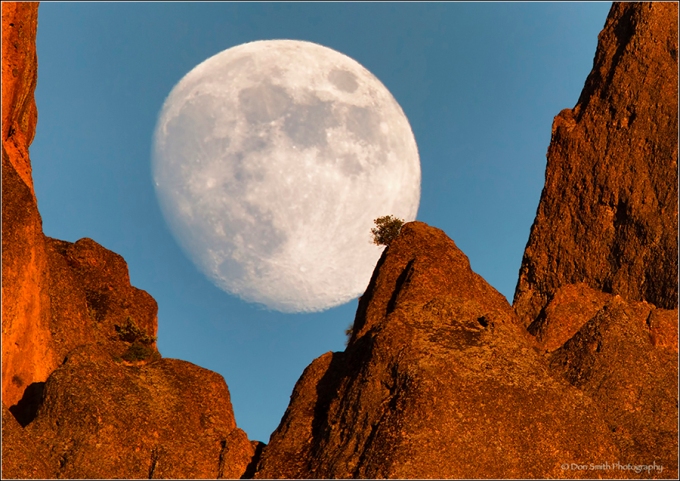
Full Moon Over Pinnacles National Park
Canon 5DMKIII, 800mm, f/8, 1/125th, ISO 100, Lexar Digital Media
With all the excitement of getting my new website and blog redone, I neglected to notify all of you of the url changes.
To continue reading my blog (yes I am still posting regularly), Please click on the following links:
I’m very excited about the new changes. I hope you’ll check out my latest post (and any you may have missed). My apologies for any confusion and welcome back – can’t wait to hear from all of you!
Do You Look Or Do You See? Developing Your Creative Vision :: Part 2 of 3
Posted on June 2, 2014
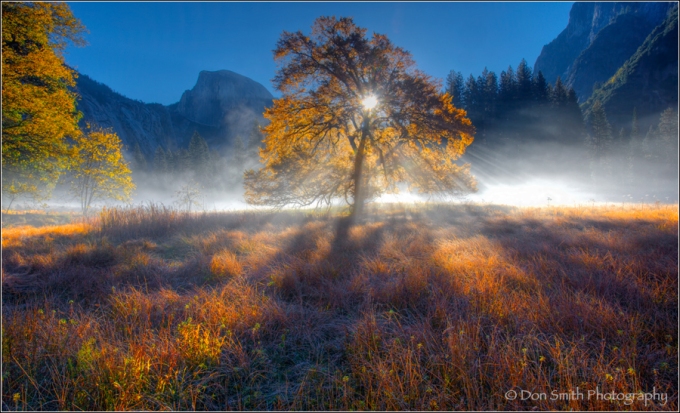
Back-lit Elm, Cooks Meadow, Yosemite National Park
Canon 1DsMKIII, Canon EF 24-70mm f/2.8L II USM Lens, f/22, 1/10th, ISO 100, Lexar Digital Media
This is Part 2 of a 3-part series on developing your creative vision. You can find Part 1 of this series by clicking here.
My path to becoming a full-time landscape photographer has been long a varied. If you read PART 1 of this series, then you know I started photographing landscapes back in my teenage years. You’ll also come away with an understanding that to become a really good photographer, you have to learn your craft and constantly work to improve your creative vision.
Once I turned professional, my landscape work took a backseat to my full-time pursuit of professional sports photography. I never stopped mind you, it was just not the way I made my living. I did that by photographing America’s pro sports: MLB, NBA, NFL, and NHL. Of the four, I still shoot the NHL as co-team photographer for the San Jose Sharks.
This meant lots of travel. My way of relaxing while on the road back then was to actually go out in my off-time and photograph landscapes all over the United States. By my count, I’ve photographed in 48 of our 50 states. Pretty cool!
What it also allowed me to do, was to develop my creative eye for fine art landscape photography without the pressure of having to succeed at it financially to feed my family. Not that sports photography wasn’t creative, but it just involved a completely different mindset.
Passion is what drives me. I was just born to do what I am doing, and believe me, I fought the idea for years! When I finally gave into the fact that this is who I am and this is what I do, then my life really changed (perhaps the old “sink-or-swim” theory kicked in)! One truism: when you dedicate your life to being an artist (in any genre), you will live with a certain amount of financial uncertainty.
Passion is what drives me. I was just born to do what I am doing, and believe me, I fought the idea for years! When I finally gave into the fact that this is who I am and this is what I do, then my life really changed (perhaps the old “sink-or-swim” theory kicked in)!
I never bought in to that old “starving artist” theory, so I made money with my camera shooting commercial work along with sports. Granted there were some jobs I really didn’t want to do, but they helped pay the bills. My dad was self-employed and I learned a lot by watching how he and my mom navigated his business. Hard work and treating people right being at the top of the list.
Looking back, there could have been some really lean years early on. But I was so blessed to have my wife Beri’s love and support – she is still there for me every day – she accepted me and what I do for a living and didn’t try to change me. She also told me that she would work full-time, which in-turn allowed me to grow my business at a steady pace without having to be the main bread-winner.
That freed my mind up to really concentrate on becoming the best photographer that I could be, and I still do it every day of my life. I made a commitment to work at both my craft and creative vision as hard as I could.
Take Time To Develop Your Vision :: It Does Not Happen Overnight
Ten years ago, Beri and I decided to make a go of my landscape photography. That’s another story for another day, but suffice it to say we are still working at it – step-by-step, day-by-day. It’s not an easy path to follow.
In my previous blog, I broke my photography into two parts: Craft (camera / processing) and Vision. I said that if you worked hard at your craft, you could learn it in a year. But that is working every day – most of you don’t have that luxury, so give yourself a bit more time.
Learning the camera is pretty straightforward. Post-processing gets a bit trickier and is really personal. We all read images differently and our processing is a personal statement about the scene that we are presenting. Post-processing in and of itself is a very creative activity.
I can help shortcut you through the process with my new video series: A Simplified Method to Workflow. I show you step-by-step how I process and work you through setting up your computer, processing RAW files and finishing off in Photoshop. I even show luminosity masking, using Tony Kuyper’s luminosity mask action palette. Learn this last step and you can re-create any scene you photographed as you intend (you’ll throw away your HDR programs – guaranteed)! Tony has great tutoriols on his site and I go over the basics in my video series.
So, that brings us to what I consider the most critical part of photography – developing your creative vision. If the craft part can be accomplished in a year or two, then you may be dismayed to hear that vision takes years and years. Really mature vision does not happen quickly – it really is a culmination of all of your life-experiences. You’ll never stop learning how to see, but through the transformation, you’ll stop merely looking. The scene in front of you will become a starting point only for your creativity.
The really cool part is that you’ll start seeing the potential for images everywhere you go! Exotic locations are awesome, but when you make the leap to really seeing, your everyday surroundings can be mined for nuggets!
For me, it started with a serious study of composition, light, art (color and depth), and design. Let’s take a closer look at all four and see how we can tie them together to help your creative vision. For this article, I will discuss my thoughts on composition and light. In Part 3, I’ll discuss the importance of art and design.
The Study Of Composition
The foundation of any good image is a strong composition. If you have a scatter-shot approach to your photography, perhaps you should re-think how you work. Fine Art landscape photography for me was just the opposite of my sports photography work.
I made my living with sports primarily because I loved the sports I was photographing, understood them almost as well as the coaches and players, and I was blessed with really good hand/eye coordination. I worked part-time for Sports Illustrated and started before autofocus lenses were a reality. That meant manual focus on fast-moving subjects with 400mm and 600mm glass. One could either do it or not. Somehow I was born with this talent. I went on to become team co-team photographer for the NHL’s San Jose Sharks (still am today).

San Jose Sharks Tomas Hertl scores a goal on a shot fired between his legs and over the shoulder of New York Ranger goalie Martin Biron
October 8, 2013, SAP Center, San Jose, California
Canon 1DX, Canon EF 28-300mm f/3.5-5.6L IS USM Lens, f/7.1/ 1/250th sync, ISO 200, PocketWizard MultiMax 32 Channel Transceiver Radio Slave, (8) Speedotron 2401SX 2400 Ws Power Supply (120VAC) and Speedotron 105 CC UV Quad-Tube Lamphead (220/240VAC), Lexar Digital Media
It means quick timing and and even quicker movements – pro hockey players move really fast! I’m at my best when I can find my zone (similar to the athletes). Once I get there, it seems as if everything goes into slow motion. Can’t explain this one either other than to say I go into a very deep concentration and block everything else out. It took me years to learn how to do this. I had to become emotionally unattached; in other words, when I am photographing a game, even if it involves my beloved Sharks, I cannot allow myself to become a fan, I am strictly a photographer and the players are my subject.
Once the emotion is gone, then I can really begin to concentrate on what I am doing. I try my hardest to focus my mind on what I am seeing through my camera. Anticipation is key, and staying as relaxed as possible is essential. If I’m tense, I can’t react – I’ll be a fraction off and that will be enough to cause me to miss the shot.
Pro athletes talk all the time about staying on an even keel. Former Shark, Torrey Mitchell, once told me and my sons that the Shark players had a rule: if they won, they got up for 5 minutes then came back to even; if they lost, they allowed themselves to get down for 5 minutes then had to get right back to even. Great advice for not only photography, but also life! In other words, being too high or too low messes with your ability to really see and concentrate. Try to stay as even keel as possible and you will be at your best to really tune-in to your subject.
When I go out to shoot landscapes, concentration and finding the zone are still key for me. But I am not rushing. It took me years to learn how to slow down (that was not part of my makeup when I was younger, but getting older is actually helping in that regard). Being on a tripod is key, but I don’t start there – I start with my camera off my tripod so I am more free to move around. Only when I find my composition do I bring in the sticks.
Moreover, I have to have an emotional connection to what I am photographing. I call this “paying attention to my emotional tugs.” When I am really in the zone, and really seeing well, then I have opened myself up to allowing these emotional tugs to communicate with me. I tend to make my best images when I am alone and really into this process; it’s nearly impossible to get there while I am teaching a workshop because my main goal is not my photography; rather, it’s helping my students with their photography. I take my camera along because it helps me see as a photographer and allows me to call out potential scenes to my participants.
I’m not big on compositional rules and theory. I keep it simple. In my mind, I assign visual weight to all the elements in my scene. I envision my composition sitting on a fulcrum point. I want the composition to feel balanced. If I add an element to the right of center, I try to counter-balance by adding an element to the left-of-center. It’s a feel thing and hard to put in to words, but I trust my inner sense of visual balance, you need to do the same. If the scene feels unbalanced, then study the composition and try to figure out why. It’s kind of like completing a puzzle, but only you can get the pieces to fit right.
I really enjoy this challenge and find it fun to work through each composition. Of course, when the light is rapidly changing, the whole process has to get kicked into high gear; yet, this can be mitigated by anticipating the light and finding your composition prior to the good light arriving.

Salsify Against Sunset Light
Canon 5DMKIII, Canon EF 100mm f/2.8L Macro IS USM Lens, f/5.6, 1/80th sec., ISO 400, Lexar Digital Media
Of course balance is just one part of composition, depth, or at least creating the illusion of depth, is another and one I will discuss more in-depth (pardon the pun) when we look at the study of art in Part 3.
But finding a good composition is only the starting point. Next, and perhaps more important, is finding the right light.
Finding The Light
It is no big secret that most fine art landscape photographers like working around the fringes of the day. Why? Because that is when the light is most interesting. That’s not to say you can’t find good quality light during the day, but I live in California, where 6 months out of the year we have blank-blue skies. Great for taking Chamber-of-Commerce images, but not fine art landscape images.
So that means getting up in the dark to be on-location 45 minutes prior to sunrise to photograph dawn light, and also staying well beyond sunset to chase dusk light.
In the image of the back-lit elm that starts off this article, I actually had to wait for the sun to crest Yosemite Valley’s Cooks Meadow. It was easy to see where the sun was going to rise and the unexpected bonus was the rising mist coming off the Valley floor. As soon as the sun crested, the elm tree exploded into vivid backlit yellows and the warm foreground grasses came to life!
Prior to the sun rising, this scene was pretty, but the light was boring. It allowed me time to think through my composition, at least a starting composition. Once the light arrived, I fine-tuned my composition (in this case, I moved the camera lower to the ground to emphasize the warm foreground grasses), which I could not see nor anticipate prior to the sun cresting.
The macro image of the salsify above was captured near sunset. I simply setup my camera, composed the shot, then waited for the sun to lower and warm the salsify. My earlier attempts were technically correct, but it was the warm light that gave this image its soul.
As the sun rises or sets, the light becomes warmer due to light-scattering. It has to do with the way light wavelengths are transmitted and I could bore you to death with it but I won’t. Suffice it to say, the cool rays of the spectrum are scattered allowing just the warm light to pass through. The light is directional and warm and fleeting, so be prepared.
Below you see an image of dancing sunflowers. I was out an hour before sunset attempting to freeze these sunflowers with a 300mm lens. Mother Nature had other ideas and decided to add a 25mph wind. As the sun lowered to camera-left and warmed the scene, I gave into my frustrations of trying to freeze the flowers and instead, allowed them to dance and paint themselves onto my camera’s sensor (as the tag line for the old commercial used to say, “you can’t fight Mother Nature).”
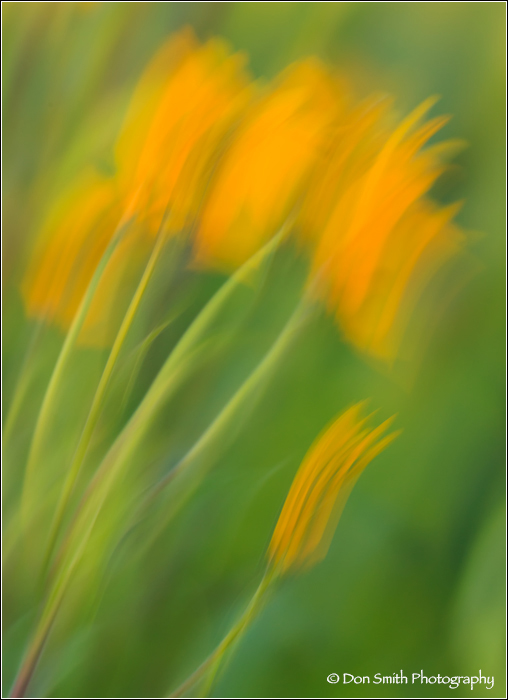
Dancing Sunflowers
Canon 5DMKIII, Canon EF 300mm f/4L IS USM Lens, f/5.6, 1/80th sec., ISO 400, Singh-Ray 77mm LB ColorCombo Polarizer Thin Mount Filter, Lexar Digital Media
Again, without the quality of the low-angled sunlight, this scene would have recorded too cold and uninteresting IMO, and earlier frames bore that out.
Please come back for Part 3, where I will explore the importance of studying art (color/depth) and design and show examples of how both can aide in improving your creative vision.
Free Video Sample :: Chapter 19 – Introduction to Luminosity Masks
2014 Photo Workshops – Complete List
2015 Photo Workshops
Software Discounts
Photomatix Pro 4.2 type in code at checkout: donsmithphotography 15% discount
Topaz Software type in code at checkout: SMITHPHOTO 10% discount
Helicon Focus click on link to receive 15% discount
Tony Kuyper Luminosity Action Palette click on link to receive a 15% discount
Hardware Discounts
MindShift Gear rotation180° Panorama rotating day hiker backpack
Special offer From Singh-Ray Filters: You will receive 15% off of any filter(s) you order when you call Singh-Ray direct and use my code – Smith 15: (800) 486-5501. Offer valid through June 13th!
Do You Look Or Do You See? Start With 10,000 Hours Of Practice :: Part 1 of 3
Posted on May 31, 2014
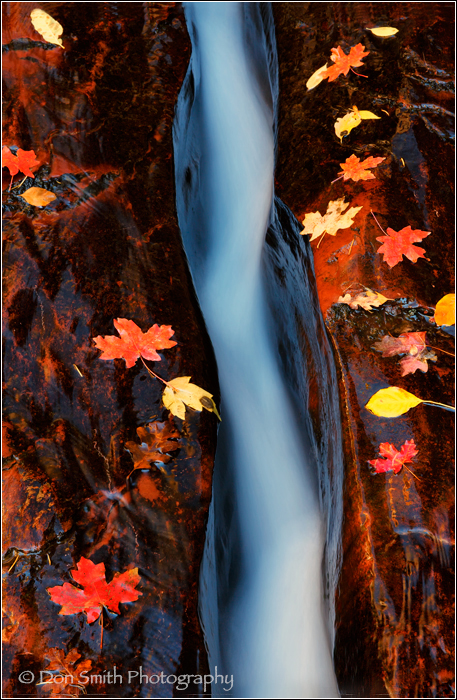
The Crack, Zion National Park, Utah
Canon 5DMKIII, 70mm, f/16, 1.3 sec., ISO 100, Singh-Ray Thin LB Polarizer, Lexar Digital Film
NOTE: This is the first of a three-part series on the art of seeing creatively. We are all creative to one degree or another, but our vision can be developed similar to our craft skills. I don’t buy into the assumption that “you were born that way.” Like anything else in life, some people have an easier time than others in anything we do (including photography), but I don’t personally believe that I was born with any special gift. In fact, in my first serious college photo class, I got a C- and the instructor wrote that in no way should I ever consider doing photography for a living. Looking back, that was great motivation. I love proving the naysayers wrong. Hard work, lots of study, a strong self-belief and lots of love and support from my wife, Beri, was the way I improved my vision (I still work at it daily).
In Part 1, I take a look at the difference between craft and vision.
Over the course of my career, I have literally learned how to get past seeing literally (at least I hope I have). What I mean by this is that when most of us first pick up a camera, we tend to think that we have to re-create the world exactly as it appears to us. That’s fine and that is a good way to really get a handle on how to operate the camera and learn how it sees with its various lens focal lengths.
I call this the “craft” side of photography. That craft side also extends to learning how to correctly process an image (I shoot in RAW mode and process using both Lightroom 5 and Photoshop CC). I can help you here also, please order my new video series: A Simplified Method to Workflow. You’ll receive 6.5 hours of training via 26 easy to follow videos. You’ll start processing like a pro within your first few lessons!
You really need to get proficient at both your camera and your post-processing; yet, craft is only half of the equation; vision (artistic vision) is the other half.
I’ve seen many of my workshop students over the years really struggle with the craft side. They are so consumed with trying to learn how to operate their camera(s) that making (notice I didn’t say taking) an image is almost an afterthought. Then, they are back at their computers trying to figure out how to properly process the image to match their vision – it can get very frustrating and confusing.
With all it takes to sort through all the craft side of the equation, it’s no wonder most photographers never really get to the vision side. I can tell you from experience, excellent craft skills without artistic vision will only equate boring images with no soul, but at least they’ll be crafted well. How do I know? Because I was one of those who thought if I just learned all the bells and whistles of my camera, then my pictures would be awesome. Well, looking back, they were awesomely boring. This was in the film days when I was shooting chrome.
Then Photoshop came along and suddenly we were the lab. Again, I dove in head-first trying to learn the beast. Still didn’t make me any better as a photographer, but at least I could process my images to my match my vision of a scene, so it was a step in the right direction.
I believe the craft of photography can be learned within a year, but it has to be practiced almost daily. In the book Outliers, Malcolm Gladwell follows highly successful people from all walks of life and determines that the one common thread between all of these people is that they put in a minimum of 10,000 hours of practice before reaching their maximum potential. Have you put in your 10,000 hours on your photography?
You really need to get proficient at both; yet, craft is only half of the equation; vision (artistic vision) is the other half.
My first camera was purchased when I was 13-years-old (45 years ago – Yikes!). Over the past 35 years, I rarely skip a day when I am not either shooting, processing, teaching, reading or writing about photography. Some days go as long as 15-20 hours when I am teaching a workshop, shooting stock, or scouting for a new workshop.

Dawn at Hanalei Bay, Kauai, Hawaii
Canon 5DMKIII, 24mm, f/16, 6 minutes, ISO 100, Singh-Ray 10 stop mor-slo neutral density filter, Lexar Digital Media
I ran some quick math, and in the last 35 years, I’ve put in 102,200 hours on my craft. That’s not even counting the first 10 years that I owned cameras. My best guesstimate for that time frame was another 14,600 hours for a combined total of 116,800 hours and counting!
Along the way, I earned a BA in Photojournalism and English from San Jose State University, worked 23 years (and counting) for the NHL’s San Jose Sharks, spent 26 years photographing MLB, NFL, NBA and NHL games, along with a host of other sports. I worked 7 years as a stringer for Sports Illustrated, and have been making landscape images since my teenage years.
I have also been teaching photo workshops for 10 years and have been shooting landscape imagery for Getty Images for the past 8 years. Eighty percent of my efforts these days are spent in the landscape realm.
All told, I have put in my 10,000 hours over 11 1/2 times (rapidly closing in on 12 times)!
I ran some quick math, and in the last 35 years, I’ve put in 102,200 hours on my craft. That’s not even counting the first 10 years that I owned cameras. My best guesstimate for that time frame was another 14,600 hours for a combined total of 116,800 hours and counting!
Here’s the bottom line. I can teach you the craft. I can teach you the aesthetic side of photography (the vision – though that takes much longer). What I cannot teach or help you with is PASSION. I can’t put in the time for you – only you can do that and everyone does it differently.
Passion is what stirs the drink so-to-speak. Passion is what will push you daily to achieve your first 10,000 hours. Perhaps many of you reading this have already surpassed that point – if so – congratulations. Now get going towards your second 10,000 hours.
The cool thing is that your journey will never end as long as your passion burns. I really can’t explain why, after all these years, I still have the passion. I do have some thoughts on that subject though and I will share them with you in Part 2 of this series.
One thing I do know is that when I was young, I focused (pardon the pun) far too much on technical and not enough on learning how to see. Once I started to put my attention towards that goal, my images began to change. No longer was every image a grand view of exactly what I was looking at; my images became more intimate like this image of Zion’s Crack that you see here.
I realize most of you reading this have a job or school and a ton of other responsibilities. Well, even though I do this for a living, I also have a family and the time constraints of running my business.
Yet, like you, I have to look at my calendar and carve out my shooting times. I’m fortunate in that half of my office time is spent outdoors scouting locations and waiting for the right light. My actual shooting time is probably less than you think. I work in very small windows of opportunity. Yet, I maximize the time I do spend in the field with adequate preparation. Then of course, Mother Nature can change on a moment’s notice. As a pro, I still have to come back with a good image.
So get after it. Don’t feel like lugging out your 35mm gear? How about taking a walk around your neighborhood with your smartphone (challenge yourself to find an image in your everyday surroundings). You will be amazed what this will do for your creativity.
Yes you can teach yourself how to see creatively. Come back for Part 2 and I will share more on how I accomplish this.
Free Video Sample :: Chapter 19 – Introduction to Luminosity Masks
2014 Photo Workshops – Complete List
2015 Photo Workshops
Software Discounts
Photomatix Pro 4.2 type in code at checkout: donsmithphotography 15% discount
Topaz Software type in code at checkout: SMITHPHOTO 10% discount
Helicon Focus click on link to receive 15% discount
Hardware Discounts
MindShift Gear rotation180° Panorama rotating day hiker backpack
Special offer From Singh-Ray Filters: You will receive 15% off of any filter(s) you order when you call Singh-Ray direct and use my code – Smith 15: (800) 486-5501. Offer valid through June 13th!
Photographing Wildflowers In The Wind At Big Sur’s Garrapata State Park
Posted on May 29, 2014

Thistles and California Golden Poppies, Rocky Ridge, 1850 feet, Garapatta State Park, Big Sur Coast, California
Canon 5DMKIII, 24mm, f/16, 1/200th, ISO 400, Singh-Ray Thin LB Polarizer, Lexar Digital Media
Yesterday was quite rewarding for me in more ways than one. A friend of mine, Sara Singleton, had notified me that the Garapatta Rocky Ridge Loop Trail was open and the wildflowers were amazing!
I immediately called my friend/colleague Mike Hall and asked if he was up for a tough hike. The summit of Rocky Ridge is 1850 feet above the Pacific Ocean. Most hikers start this 7-mile loop through Soberanes Canyon.
We decided that the most direct route was up the western face (our cars are parked along the side of Highway 1 seen paralleling the ocean as seen in the top right of this image).
More than getting to experience and photograph spring wildflowers, it was a chance to test my partial knee replacement. Doctor Ting had run his final X-Ray’s last week and said that I was good to go. I hadn’t tried this hike in over two years.
It took us about 75-minutes to reach this location, but as you can see by the amazing views, the climb was more than worth it.
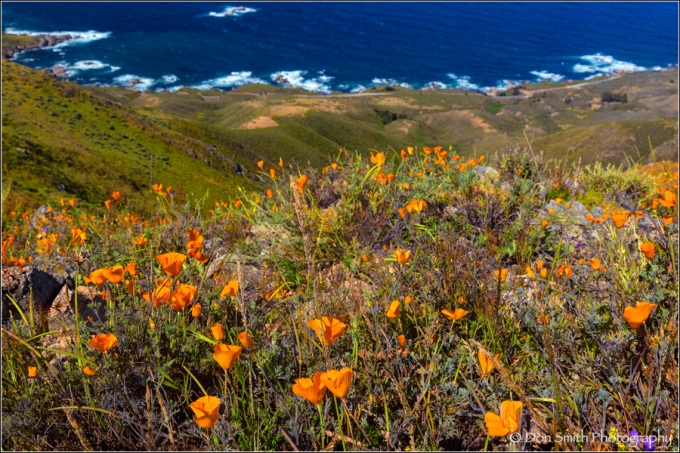
Poppies and Big Sur Coast, Rocky Ridge, 1850 feet, Garapatta State Park, California,
Canon 5DMKIII, 35mm, f/16, 1/320th, ISO 400, Singh-Ray Thin LB Polarizer, Lexar Digital Media
As I pulled into the parking area, I knew we could be facing some stiff winds. Our summer fog season has not started in earnest as of yet and the winds whipping off the Pacific were rather stiff.
One of the cool things about shooting poppies is that one has to wait for the sun to climb. From past experience, I knew that the poppies would not start opening until 9am.
Sure enough, the winds were very brisk atop the 1850-foot summit of Rocky Ridge. We knew we wanted to stay on the west-facing slope in order to use the incredible coastline as a background. Talk about million dollar views!
When photographing wildflowers in the wind, the number one concern is shutter speed. Is there one speed that fits all scenes? Unfortunately no.
Picking a correct shutter speed to stop the bobbing flowers is a function of focal length, aperture, your distance to the flowers, and speed of the wind, which was not constant.
Waiting for lulls in the breeze was one thing to consider, but we also knew we had a limited window to photograph as the sun was climbing and once it got too high, we would lose any sense of modeling with the flowers and landscape.
I made sure I stayed as far off-angle from the sun as possible and used my Singh-Ray Polarizer to minimize the glare of the waxy sheen on the foliage. This allowed for deeper saturation of the colors.
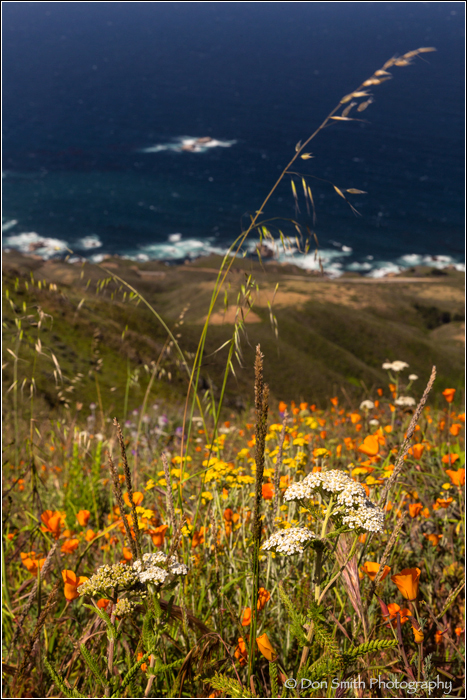
Poppies and Yarrow, Rocky Ridge, 1850 feet, Garapatta State Park, Big Sur Coast, California
Canon 5DMKIII, 57mm, f/16, 1/250thth, ISO 400, Singh-Ray Thin LB Polarizer, Lexar Digital Media
As you can see with these three images, 1/200th was longest shutter that I chose. Fortunately the breeze lessened as the sun rose higher.
My method for determining the correct shutter speed for each composition was as follows:
Compose my scene with camera off the tripod.
Once I find a pleasing composition, I bring in the tripod for support and to allow me time to slow down and check the edges of my frame.
Now I determine what aperture I wish based on depth-of-field considerations.
Next, I set the shutter using the lowest ISO I can.
Take some test shots and check back of LCD blown up 100%.
If I need a faster shutter, I either raise the ISO, and/or give back some exposure by opening my aperture.
That’s it. I do try to find a suitable foreground element. Perhaps the diciest part of yesterday was paying attention to an abnormal amount of lizards, ticks (Garapatta is Spanish for tick), and snakes. We were walking and laying in deep grasses.
As Harrison Ford (Indiana Jones once quipped) “I hate snakes!”
So the rewards that I mentioned at the start of this blog? Well they were: An awesome day spent hiking/photographing with a good friend, beautiful scenery, and best of all, no pain in my knee!
Free Video Sample :: Chapter 19 – Introduction to Luminosity Masks
2014 Photo Workshops – Complete List
2015 Photo Workshops
Software Discounts
Photomatix Pro 4.2 type in code at checkout: donsmithphotography 15% discount
Topaz Software type in code at checkout: SMITHPHOTO 10% discount
Helicon Focus click on link to receive 15% discount
Hardware Discounts
MindShift Gear rotation180° Panorama rotating day hiker backpack
Robert’s Distributors – 10% off any regularly priced camera bag and a free memory card wallet with any purchase. Call John or Nick at 800-726-5544 and reference you saw this posted on my blog site.
Grand Teton Photo Workshop :: September 28 – October 2
Posted on May 26, 2014
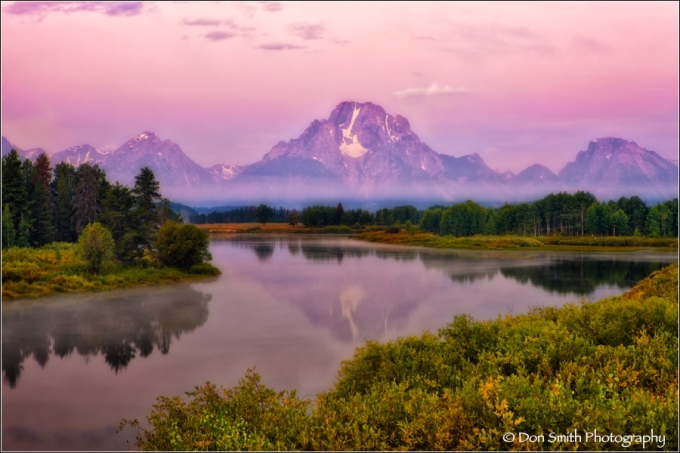
Dawn’s Hues, Oxbow Bend, Grand Teton National Park, Wyoming
Canon 1DsMKIII, 70mm, f/16, 4 seconds, ISO 100, Singh-Ray Thin LB Polarizer, Lexar Digital Media
Join me, along with Scott Schilling and Pierre Steenberg for my 3rd Annual Fall in Grand Teton National Park Workshop this September 28 – October 2, 2014.
Come photograph one of America’s grandest National Parks in one spectacular fall workshop. The aspens and cottonwoods will be at or near peak color with the dramatic sweep of the Grand Teton Range and the iconic Snake River serving as a backdrop.
Above is just one sample of the breathtaking beauty that you will see and photograph. This image was captured at dawn at famed Oxbow Bend.
Words simply won’t do this justice, so I thought I’d let some images do the talking.

Stormy Evening, Snake River Overlook, Grand Teton National Park, Wyoming
Canon 1DsMKIII, 32mm, f/11, 2.5 seconds, ISO 200, Singh-Ray Thin LB Polarizer, Lexar Digital Media
The Snake River Overlook was made iconic by none other than Ansel Adams. Though the trees have grown concealing the actual bend, the beauty is still exquisite. The cottonwoods to the west of the river should be showing their beautiful yellows during the workshop.
I captured this image after sunset with Mike Hall when all the other photographers had left – amazing what they missed!
As you can see in both this image and the next, snows come early in the Grand Teton range. This provides even another layer of beauty to this already amazing area.
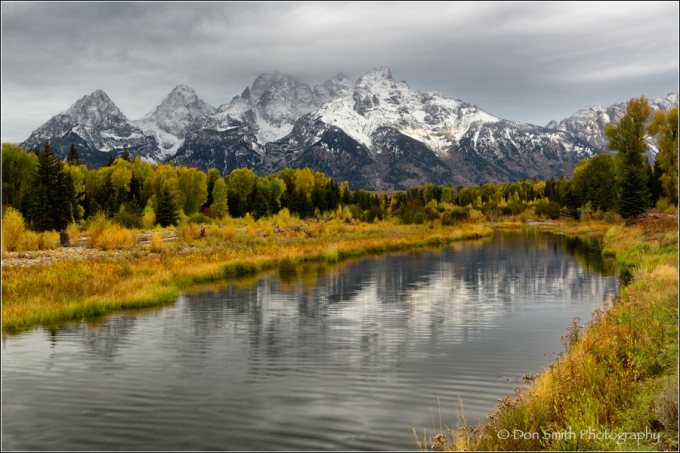
First Light at Schwabacher’s Landing, Grand Teton National Park, Wyoming
Canon 5DMKIII, 44mm, f/16, 1/4 sec., 200 ISO, Singh-Ray Thin LB Polarizer, Lexar Digital Media
We will shoot early at iconic Schwabacher’s Landing. There are so many compositional possibilities that it will boggle your mind – simply gorgeous is the only way I can describe the location.
Just to the north of this scene are the famed beaver ponds and I’ll have you on-location very early to stake your spot.
If we get lucky, the models just may show up on time. My workshop group captured this scene on the way to Oxbow Bend for a sunset shoot (below).
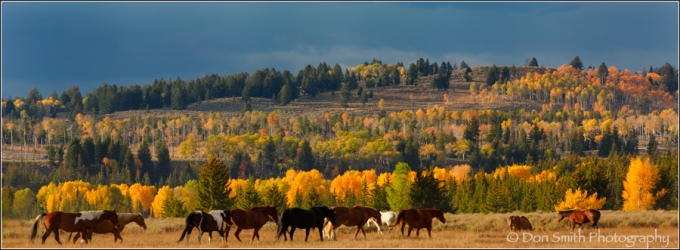
Wild Horses and Fall Color, Grand Teton National Park, Wyoming
Canon 5DMKIII, 190mm, f/8, 1/80th, 100 ISO, Singh-Ray CC Polarizer, Lexar Digital Media
When we are not out photographing, we will be holding daily class sessions dealing with workflow and vision.
As my workshop description states: This workshop will have an emphasis on field location shooting. It will also include two sessions of Photoshop training and a minimum of two image review sessions. Workflow training will include: RAW processing in using the latest version of Lightroom and complete workflow training in the latest version of Photoshop. Workflow topics will include: preparing an image for both print and web presentation, proper methods of setting white and black points, how to “properly massage the middle tones,” color balance, localized tonal and color adjustments via luminosity masking, 32-bit blending techniques, blending multiple exposures via layers and masks, freehand masking techniques, section of masks based on both tones and colors, proper sharpening and noise reduction techniques, etc.

Moulton Barn and Grand Tetons, Grand Teton National Park, Wyoming
Canon 1DsMKIII, 25mm, f/16, 2 seconds, ISO 200, Singh-Ray Thin LB Polarizer, Singh-Ray 2 stop soft edge GND, Lexar Digital Media
Of course we will spend one sunrise and perhaps one afternoon photographing along famous Mormon Row. The Moulton Barn is an iconic scene with the Teton Range serving as a backdrop and is a symbol of the west’s grandeur.
So I hope you can join in. There are (6) spots remaining as of this writing. For more information, please click here: Fall In Grand Teton National Park :: September 28 – October 2, 2014. You can also email me for more information:don@donsmithphotography.com.
Free Video Sample :: Chapter 19 – Introduction to Luminosity Masks
2014 Photo Workshops – Complete List
2015 Photo Workshops
Software Discounts
Photomatix Pro 4.2 type in code at checkout: donsmithphotography 15% discount
Topaz Software type in code at checkout: SMITHPHOTO 10% discount
Helicon Focus click on link to receive 15% discount
Hardware Discounts
MindShift Gear rotation180° Panorama rotating day hiker backpack
Robert’s Distributors – 10% off any regularly priced camera bag and a free memory card wallet with any purchase. Call John or Nick at 800-726-5544 and reference you saw this posted on my blog site.
My New SmugMug Pro Website Is Now Live!
Posted on May 24, 2014
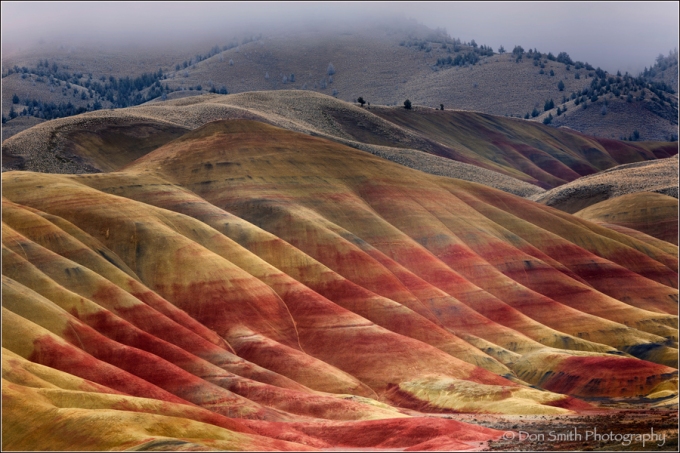
Painted Hills and Mist, John Day Fossil Beds National Monument, Oregon
Canon 5DMKIII, 185mm, f/11, 1/4th sec. 100 ISO, Singh Ray CC Polarizer, Lexar Digital Media
It has been a 18-month journey from concept to reality, but my new website is finally live! If you’d like to check it out, then click here: Don Smith Photography
But hopefully, you’ll be back to read all about it how it came to be!
Let’s rewind a couple summers back. I had returned from a trip to Europe with my family after having visited and photographed Paris, London, Edinburgh, and St. Andrews (yes, even got to play golf at the Old Course)!
I had met and became friends with Ivan Makarov, who works for SmugMug. Ivan is a huge San Jose Sharks fan and is also an awesome photographer. He had sent me an e-mail inviting me to tour the SmugMug offices and meet the staff and president Chris MacAskill.
We finally got together for lunch at the SmugMug offices a few weeks later and I had the pleasure of meeting many of the staff along with Chris. I was immediately impressed with the professionalism of everyone. They all made me feel right at home.
Chris is an accomplished photographer also and I was given a tour of the facility. SmugMug’s walls are decorated with backlit (Duratrans) images from various pros and staffers – in short – it was awesome. I felt as if I was in a high-end gallery!
After the tour, I ended up in Chris’s office. I remember he had just purchased the Canon 1DX. We spent the next 30 minutes talking about photography and he had mentioned that if I ever wanted a site built, that his staff could handle it. He also told me the story of how SmugMug was started. They are a true Silicon Valley success story and he and his son built the company a step at a time with a ton of hard work!
Chis also had mentioned that he had seen an image that I had captured of the Eiffel Tower during my trip and asked if I would allow them to make a very large Duratrans. I was honored!
The image was/is so memorable for me because my son Aaron came along and shared the experience. We were both exhausted from a full day of sightseeing, but I also knew we would be leaving for London in a few days and the weather was cooperating, so off we went. This image was captured from the top of Paris’ Montparnasse near sunset (thanks to a tip from Bay Area resident Mike Brazil).
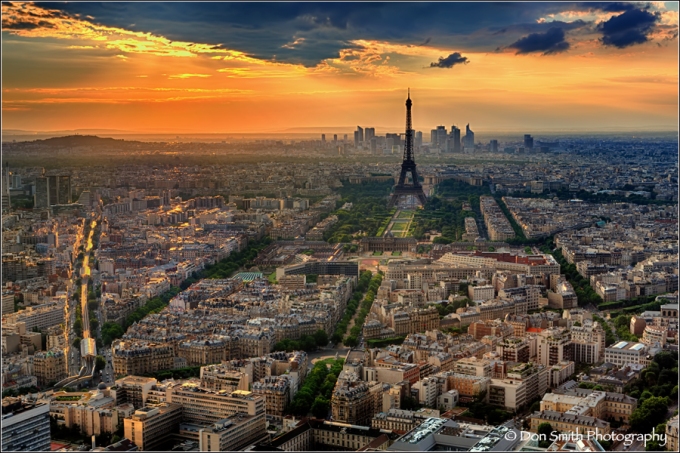
The Eiffel Tower and Sunset Sky, Paris, France
Canon 5DMKIII, 52mm, f/22, (7) bracketed exposures combined with luminosity masks in Photoshop, ISO 100, Lexar Digital Media
I left the SmugMug offices thinking, hey, this could be cool. Yet, as time passed and schedules once again ramped into high-gear, the idea got placed on the back-burner.
That was until Ivan e-mailed me an invitation to attend the press conference unveiling the new SmugMug redesigned websites. Again, my schedule was too tight to attend, so Ivan sent me a link to watch it live via my computer.
Within 5 minutes, I was hooked. The more I watched and learned, the more I knew that this would be the website for me. It was all there: eye-popping designs, clean looks, exceptional image display, a plethora of templates for a personal look, easy navigation, integration with mobile devices, helpful tutorials, friendly staff, security, e-commerce – it had it all!
Fast forward to this past February. I was contacted by SmugMug’s Steve Mills. Steve made an offer to have SmugMug build me a website. Within a few days, I was contacted by another SmugMug employee, Tomasz Nowicki.
I remember sheepishly telling both that due to my workshop schedule, travel, and my commitments to the San Jose Sharks (I’m co-team photographer), that I did not have time to think about a new website. I was literally working 7 days a week, with extremely grueling hours.
It was all there: eye-popping designs, clean looks, exceptional image display, a plethora of templates for a personal look, easy navigation, integration with mobile devices, helpful tutorials, friendly staff, security, e-commerce – it had it all!
Tomasz and I set a date to get back together once my work schedule slowed a bit.
We re-connected on April 1, and after a phone consultation (Tomasz lives in London and I live in California) as to what I was looking for, Tomasz took the reins and ran with them. We would talk about once per week and exchange e-mails, but he was amazing. He basically merged my existing site with my new SmugMug site – he’s a pure genius!
Turns out Tomasz is also an accomplished photographer. Check out his site: Photom.me
Are you seeing a pattern here? Everyone I’ve mentioned is not only a SmugMug owner or employee, but also a passionate photographer. That means they get it from a photographer’s perspective because they think like a photographer.
As we neared the finish line, I realized that my existing site was set to expire if not renewed by this past Thursday. Tomasz went into another gear and had my site ready to go within a week. He contacted me last Saturday with final instructions, and the site went live this Wednesday!
With even more help from Tomasz over the past week, I have been working non-stop adding new Galleries and images, checking and re-checking links and information, and setting up security.
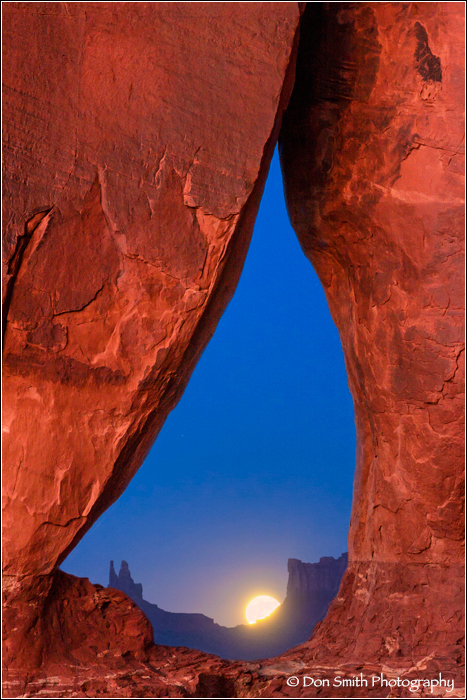
Moonrise Through Teardrop Arch, Monument Valley, Arizona
Canon 5DMKIII, 70-200mmL II, f/11, (2) images focus-blended, (5) exposures masked using luminosity masks in Photoshop, ISO 400
Through all this, Steve Mills, had been working with me on test prints to BayPhoto.com (my personal lab) and the one I selected to handle my customer’s print orders. I’m now confident that my potential customers will be thrilled with the quality of the prints they order.
NOTE: Though you will see my copyright over my photos while browsing galleries, it will not appear on an actual print.
I also thought long and hard about print pricing. As you know, fine art images are usually priced extremely high. After much discussion with my wife Beri, we decided to offer my prints at a price we think will be affordable to anyone interested.
We offer a bevy of sizes and finishes (even framing and cards). It’s all there with a few simple clicks of the mouse. The cool thing is that your image will be printed and shipped within 2-5 days (depending on size and surface – canvas taking a bit longer). Regular prints are shipped within 24 hours of you placing the order.
So a heartfelt thanks to everyone at SmugMug for making this all happen. If you have been considering a new website, please check out what SmugMug has to offer. I think you’ll be thrilled – I know I am!
Free Video Sample :: Chapter 19 – Introduction to Luminosity Masks
2014 Photo Workshops – Complete List
2015 Photo Workshops
Software Discounts
Photomatix Pro 4.2 type in code at checkout: donsmithphotography 15% discount
Topaz Software type in code at checkout: SMITHPHOTO 10% discount
Helicon Focus click on link to receive 15% discount
Hardware Discounts
MindShift Gear rotation180° Panorama rotating day hiker backpack
Robert’s Distributors – 10% off any regularly priced camera bag and a free memory card wallet with any purchase. Call John or Nick at 800-726-5544 and reference you saw this posted on my blog site.
Where’s Your Comfort Zone?
Posted on May 20, 2014
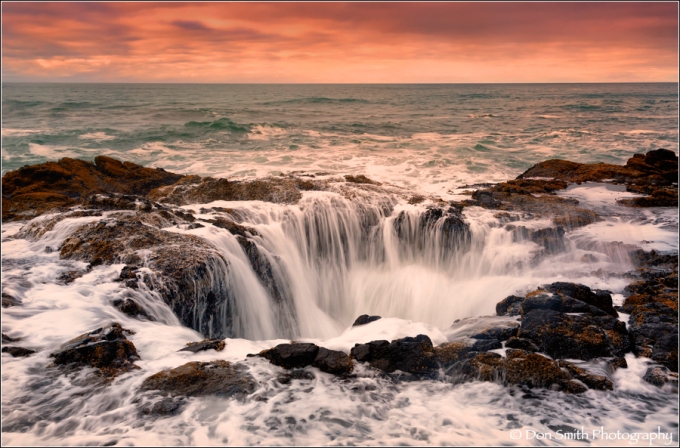
Thor’s Well, Cape Perpetua, Oregon
Canon 5DMKIII, 35mm, f/16, 1/8th sec., 100 ISO, Singh-Ray 2 stop hard-edge GND, Singh-Ray Thin LB Polarizer, Lexar Digital Media
Let’s face it, we all have our comfort zones in every aspect of our lives.
I’m enjoying one right now. I like waking early, grinding my Starbucks coffee, and writing a blog (I promise, this one will be a lot less contentious than the one of fracking).
I had always wanted to visit Cape Perpetua, Oregon (approximately 160 miles south of Portland) to photograph Thor’s Well. In December 2012, I finally got my opportunity. It was amazing. I remember my pulse accelerating the moment I looked down from the parking area off Highway 101.
Located along the Cape Perpetua shoreline lies Thor’s Well, essentially a large hole in the rock shelf where incoming waves and swells push underneath with their surge (kind of a mini blow hole affect), then withdrew back to sea pulling all the water with its retreat making a toilet bowl flush affect (how’s that for a visual)!
According to the rangers at the nearby Visitor’s Center, Thor’s Well is best seen approximately an hour before high tide to an hour after high tide. How spectacular the sights are is a function of the height of the high tide and the direction and size of the swells. The wind can also be a factor.
The day my friend C.W. McGowen and I arrived, we were at mid-tide. Still enough for the “suck” to photograph well.
Thor’s Well is accessed from a parking overlook alongside Highway 101. I started photographing immediately from this high perch but soon realized that there was nothing stirring in me. Pretty pictures, but no emotional connection.
Thus, it was time to follow the main trail down the rather steep bluff from the parking area. As I moved closer to the rocky beach area, I noticed my pulse increasing. This is a good sign for me personally – it means that I am getting connected and excited about what it is that I came to photograph. It also means, and I’ve learned this that hard way over the years, that it is time for me to be careful.
There are no limitations as to how close one can get the Thor’s Well. I guess if one was foolish enough, they could dive right in (may be the last dive one would make). The key was not to slip, or worse, be caught and pulled in by a sneaker or rogue (and heaven forbid a freak). Thus, it was imperative that I never took my eyes off the ocean. The swells were choppy enough as it was.
My recollection was that I started on a rocky outcrop, perched about four feet above Thor and felt somewhat safe (quite frankly, a false sense looking back now). With every inch that I crept forward, the resulting frames got stronger, revealing the scary nature of the mass of water being sucked down into this endless pit (actually it was a shelf, though I did not know how deep it went). I have since researched this and found that the hole is about 20 feet deep – that’s me times 3 1/2 – scary!
There are no limitations as to how close one can get the Thor’s Well. I guess if one was foolish enough, they could dive right in (may be the last dive one would make). The key was not to slip, or worse, be caught and pulled in by a sneaker or rogue (and heaven forbid a freak).
But I also knew inside, that for the ultimate image, to really give my viewers a sense of what it is like to feel as if one was going to be sucked in, that I would have to get as close as my comfort zone would allow. I wanted to photograph Thor’s suck with a wide angle lens (35mm on a full-frame sensor). So I pushed closer, step-by-step.
I’ve learned through experience that it is at this moment, the one where my heart is pounding hard against my chest, the one where I am staring down my worst nightmare (getting sucked under into the ocean), that I personally have to recognize and respect my fear as I know my adrenaline is pumping. Adrenaline, at least for me, is what pushes me out of my comfort zone. That quest for the best image I can make. It is also what puts me on a fine-line between getting a killer image and, well, getting seriously injured or killed.
I’ll admit, it is a rush like nothing else I’ve experienced in life (except for my younger days when I downhill ski raced). Maybe that’s it, Maybe I’m trying to recapture those adrenaline-filled moments of my youth. I really don’t know.
What I do know, was that at the time I captured this frame, I was standing a mere 5 feet from the lip of Thor’s Well, on wet, slippery rocks (I remember trying to comfort myself with the thought that I could use my tripod as a brace – looking back, that was a false sense of security)!
Believe me, I didn’t stay long. I waited out and photographed three explosions of water through the well, and three suck-backs. That was enough. I had pushed the envelope and it was time to retreat to higher ground. I knew I had gotten my image and lived to tell about it.
I think the key point of revealing this story is to get you to think about how far out of your comfort zone would you go to get an image. This was a success and I lived to tell about it. But I also hear of the stories each year of people being caught by a sneaker or freak wave. Or those that fall off Yosemite’s many falls trying to get that vicarious look straight down. Heck, Gary Hart and I taught two monsoon workshops at the Grand Canyon last year (and are teaching two more this year) where we allow students to photograph lightning storms (we do go over a stringent safety orientation – but really, with lightning, you are never safe). They all know this, but they all want the experience and are willing to risk their lives to photograph lightning.
Every year we go to the Grand Canyon, we hear about someone who got too close to the edge a slipped. Nature is not Disneyland. We all know that (though I question some of the tourists that I see doing stupid things).
Personally, I just try to pay attention to my fear level (which is screaming at me to stop), and respect that it is in direct conflict with my adrenaline level (which tells me to push it even further).
I tell my students to listen to their inner voice and pay attention to what they are feeling. Pushing too far past your own personal comfort level is what leads to accidents or worse.
It’s amazing what the power of making a special image will do to an otherwise sane person!
Free Video Sample :: Chapter 19 – Introduction to Luminosity Masks
2014 Photo Workshops – Complete List
2015 Photo Workshops
Software Discounts
Photomatix Pro 4.2 type in code at checkout: donsmithphotography 15% discount
Topaz Software type in code at checkout: SMITHPHOTO 10% discount
Fracking – Not In My County!
Posted on May 18, 2014
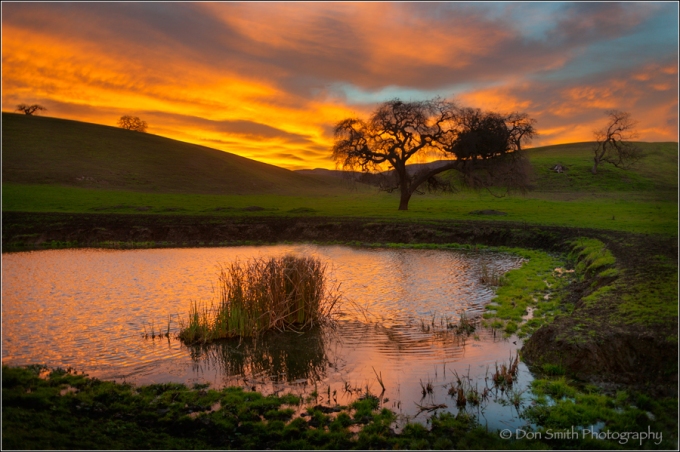
Morning Warmth, Seasonal Pond and Sunrise Sky, San Benito County, California
Canon 1Ds, 28mm, f/16, (5) bracketed exposures combined in Photoshop using luminosity masks, ISO 100, Singh-Ray Think LB Polarizer, Lexar Digital Media
California’s upcoming November election could hold extra importance for my family, friends and neighbors. We will be voting on more than school bonds and local political seats. We could be making history.
My fellow citizens and I will be the first in the state to vote for or against hydraulic fracturing in our county. If approved, this measure would prohibit fracking, and related gas and oil extraction activities.
This initiative was started by the group called San Benito Rising. On April 22, 2014, San Benito Rising turned in over 4,000 signatures to the county elections office for certification. The county registrar office now has 30 days to count and validate the signatures. If approved, a complete ban against fracking will be placed on the November ballot for the citizens of San Benito County to vote upon. Currently in California, Santa Barbara County and Butte County are attempting to gain enough signatures for similar anti-fracking measures to be placed in front of their voters.
Andrew Hsia-Coron, a San Benito Rising organizer, said, “We’re sitting here on this giant deposit of Monterey Shale, so we’re trying to stop it before oil companies even get started and invest in infrastructure.”
According to San Benito County Supervisor, Jerry Muenzer, fracking is currently allowed in our county, but with stricter fees and regulations. As Muenzer said in a recent KSBW interview, “more hoops for the gas companies to jump through.”
So why not a total ban by the San Benito Board of Supervisors? According to Muenzer, they fear that the oil companies would sue the county and unfortunately, the county does not have the financial resources to fight back (classic David and Goliath).
Andrew Hsia-Coron, a San Benito Rising organizer, said, “We’re sitting here on this giant deposit of Monterey Shale, so we’re trying to stop it before oil companies even get started and invest in infrastructure.”
Graig Moyer, an attorney for the California Independent Petroleum Association, said that the initiative would inevitably be challenged in court if it is approved.
Opponents of fracking bans, especially local ones, claim that the process is relatively safe and well regulated and that prohibiting it will cause economic depression and job loss. They also argue that the proper jurisdiction for such regulation is on the state level, not through local initiative.
The bottom-line for my family and I was that we needed to get educated, and that meant more than just watching the Matt Damon movie “Promised Land.”
One of the first pieces of information I discovered is fracking has been occurring in California for more than 30 years. The 2014 California Democratic Party Platform called for an immediate moratorium on fracking, a position not supported by California’s Governor Jerry Brown.
A couple nights ago, my wife and I watched the documentary “Gasland,” which is now airing on Netflix. It has been receiving many positive reviews as a very straightforward and accurate film, though gas companies (namely Exxon, the largest proponent and beneficiary of fracking said it contained false facts) and have countered with their own documentary, “Truthland.”
BTW – I urge any of my fellow San Benito County residents to watch “Gasland” as we learned a lot about the potential risks and unknowns of fracking.
I awoke early this morning thinking about my responsibility as a voter on this historic election. Mind you, to my knowledge, there are not any gas companies ready to drill in our county, this is just a preemptive strike by the citizens of this county.
The more I thought about it, the more I realized how educated we should all be on this subject as fracking is taking place worldwide. If you are like our family and friends, chances are you don’t know much about it either. And as my parents always taught me, there are two sides to every story.
Personally, I feel I have more of a responsibility to speak up as I make my living as a landscape photographer, one who tries to capture the beauty of nature. I’m not a die-in-the-wool conservationist (which may seem funny to a lot of you). Moreover, I don’t view myself as a political activist. But this is a big issue, and one where I feel that my vote really matters.
Thus, I’ve gone beyond simply watching a couple of films, I’ve done some research and have distilled the facts and arguments pro and con:
Arguments For Hydraulic Fracturing
Each well produces around 300,000 barrels of natural gas per day
In Pennsylvania, there has been rapid development of the Marcelius shale site. It is estimated that fracking could produce 500 trillion cubic feet of gas – enough to power all American homes for another 50 years
Proponents of fracking claim that it is a proven gas extraction method that has been used for decades (though Dr. Anthony Ingraffea, a hydraulic fracturing expert from Cornell University, says mining companies have had less than a decade’s experience of using the fracking method on a large scale)
According to a New York Times article:
Of the tens of thousands of deep injection wells in use by the energy industry across the United States, only about eight locations have experienced injection-induced earthquakes, most too weak to feel and none causing significant damage
The Pennsylvania experience with water contamination is also instructive. In Pennsylvania, shale gas is accessed at depths of thousands of feet while drinking water is extracted from depths of only hundreds of feet. Nowhere in the state have fracking compounds injected at depth been shown to contaminate drinking water
In one study of 200 private water wells in the fracking regions of Pennsylvania, water quality was the same before and soon after drilling in all wells except one. The only surprise from that study was that many of the wells failed drinking water regulations before drilling started
While the natural gas produced by fracking does add greenhouse gases to the atmosphere through leakage during gas extraction and carbon dioxide release during burning, it in fact holds a significant environmental advantage over coal mining. Shale gas emits half the carbon dioxide per unit of energy as does coal, and coal burning also emits metals such as mercury into the atmosphere that eventually settle back into our soils and waters
Europe is currently increasing its reliance on coal while discouraging or banning fracking. If we are going to get our energy from hydrocarbons, blocking fracking while relying on coal looks like a bad trade-off for the environment
In the experience of Pennsylvania, natural gas prices fall and jobs are created both directly in the gas industry and indirectly as regional and national economies benefit from lower energy costs. Europe can benefit from lessons learned in Pennsylvania, minimizing damage to the local environment
Arguments Against Hydraulic Fracturing
596 chemicals are used including: uranium, radium, hydrochloric acid, mercury, lead, and formaldehyde
It takes approximately 1-8 million gallons of water to complete each fracking job. This requires on average 400 tanker trucks to carry the water and supplies to and from the site
Currently there are 500,000 active wells in the United States alone that use an average of 72 trillion gallons of water and 360 billion gallons of chemicals. Only 40% of the fracturing fluid is recovered and the rest of the toxic fluid remains in the ground and is not biodegradable
In 2011, a study was commissioned by the EPA. There have been over 1,000 documented cases of water contamination next to areas where the companies have used the fracking process. This contaminated water is usually used for drinking water in nearby cities and towns
In 2010, Pennsylvania officials fined Chesapeake Energy $1 million for contaminating water supplies in Bradford County. Because the company had not cemented its drilling boreholes, methane gas escaped from the well and contaminated the water of 16 families
The fluid used in the fracking procedure is injected at depths of 8,000 feet. This fluid cracks the shale and allows natural gas to escape
According to the film “Gasland,” in 2005, then vice-president Dick Chaney, encouraged the Bureau of Land Management (BLM) to execute fracking leases with gas and mining companies. BLM is public land and currently has 92,000 wells. Fracking has been used in about 90% of the wells drilled on federal lands and 13% of U.S natural gas production comes from those federal wells.
According to USA Today, Rex Tillerson, CEO of ExxonMobile (the largest natural gas producer in the US that relies heavily on fracking to extract it) opposed fracking when it was proposed near his $5 million Texas home. He joined a lawsuit to block its construction with the damaging consequences of fracking cited as one of the main concerns
Fracking, was exempted by the Bush-Cheney Energy Policy Act of 2005 from the United States’ most basic environmental regulations, including the Safe Drinking Water Act and the Clean Air Act. Congress is currently looking into revising this
In Fox’s documentary “Gasland,”he reveals tap water so contaminated it can be set on fire right out of the tap; chronically ill residents with similar symptoms in drilling areas across the country; and huge pools of toxic waste that kill livestock and vegetation.
According the Fox’s website: The public remains largely unaware of the potential dangers of hydraulic fracturing, while state and local environmental agencies do not have the resources to
fully investigate or regulate the gas industry. In many instances, residents have received huge tanks of water to replace their water wells, but the smell and lingering illnesses of people and livestock attest to the damage done. Anyone able to secure compensation from the gas companies must sign non-disclosure agreements that prevent them from bringing lawsuits or informing others of their experiences with natural gas drilling
According to a New York Times article:
trucking and storage accidents have spilled fracking fluids and brines, leading to contamination of water and soils that had to be cleaned up. The fact that gas companies do not always disclose the composition of all fracking and drilling compounds makes it difficult to monitor for injected chemicals in streams and groundwater
Pennsylvania has also seen instances of methane leaking into aquifers in regions where shale-gas drilling is ongoing. Some of this gas is “drift gas” that forms naturally in deposits left behind by the last glaciation. But sometimes methane leaks out of gas wells because, in 1 to 2 percent of the wells, casings are not structurally sound. The casings can be fixed to address these minor leaks, and the risk of such methane leaks could further decrease if casings were designed specifically for each geological location
Wasting precious water needed by California
Potentially causing earth quakes
Natural gas extraction has global environmental consequences, because the methane gas that is accessed through extraction and the carbon dioxide released during methane burning are both greenhouse gases that contribute to global climate change
I acknowledge that there is much more to this issue than can be presented here; yet, after weighing the facts, my family is voting no to fracking in our county as the technology currently stands. Could we change our minds down the road? Sure. As developments in the fracking industry continue to improve (hopefully), it perhaps could become more environmentally friendly.
Though fracking would mean big dollars to our cash-strapped county, we should be looking at our other resources as revenue generators: Pinnacles National Park, San Juan Bautista Mission, Fremont State Park, San Juan Bautista Historical State Park and Eco-tourism. We have a Mediterranean climate and beautiful scenery!
As it stands now, we feel the risks far outweigh the benefits. November will be a historical election in our county. I hope our citizens take the time to do their own research as pro and con commercial and advertisements will undoubtedly be forthcoming (full of twisted facts). Beware of the spin doctors!
Free Video Sample :: Chapter 19 – Introduction to Luminosity Masks
2014 Photo Workshops – Complete List
2015 Photo Workshops
Software Discounts
Photomatix Pro 4.2 type in code at checkout: donsmithphotography 15% discount
Topaz Software type in code at checkout: SMITHPHOTO 10% discount
The Power Of Adding A Moon To Your Image
Posted on May 16, 2014
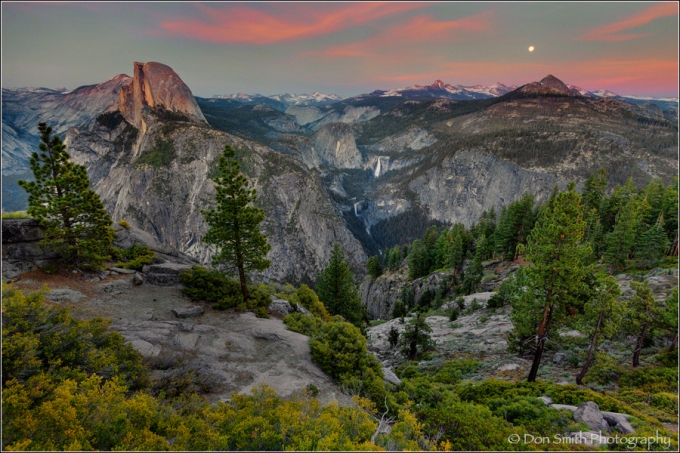
Moonrise Over Yosemite High Country, Ansel Adams Wilderness, Yosemite National Park
Canon 5DMKIII, 18mm, f/11, 2.5 seconds, ISO 100, Singh-Ray Thin LB Polarizer, Singh-Ray 2 stop, hard edge GND, Lexar Digital Media
If you have been following my posts for any length of time, then you know how important moon images are to me. They are so important in fact, that I plan many of my workshops around the full moon.
I captured this image Wednesday evening from Yosemite’s Glacier Point looking east over the Ansel Adams Wilderness just after sunset. I was co-teaching Gary Hart’s Spring Yosemite Workshop. We had the group at Glacier for a sunset shoot the evening prior.
Gary went around to all the participants and said he was going back to the Geological Exhibit Hut area to photograph the rising moon. About half the group chose to go while the other half stayed to shoot the setting sun. Gary asked if I would stay with that group.
The next day at image review, Gary showed his image and an audible sigh went up from those of us who missed the moonrise (we could not include it with Half Dome from our position). Within ten minutes, the group had voted to go back to Glacier that evening to try again.
One cool thing about the moon is that it rises, on average, about 50-60 minutes later each evening. The full moon always rises near sunset (usually, but not always, the day before the actual full moon). Gary calculated via topo software and a software program that on this particular evening, the moon would start rising to the left of Mt. Starr King about 30 minutes prior to sunset. His calculations were right on the mark. By the time I captured this image, it was 3 minutes past posted sunset. This allowed me to make the capture with only the aid of a Singh-Ray 2 stop GND so I did not lose detail in the moon; albeit very small in this image.
So why am I so moon crazy? I feel there is such an emotional draw to the moon – especially in wilderness settings. I photograph either full or crescent moons. Quarters and half moons tend not to hold as much appeal for me.
One cool thing about the moon is that it rises, on average, about 50-60 minutes later each evening. The full moon always rises near sunset (usually, but not always, the day before the actual full moon).
The other benefit of including a moon, even a small one such as this moon due to an extreme wide angle lens, is that they hold a tremendous amount of visual weight. Visual weight is not physical weight; rather, it acts as visual element that tends to keep the image in balance. Imagine this image sitting on a fulcrum point. Half Dome weighs the left side of the frame, Starr King (the peak below the moon) does act as a bit of a counter-balance for the scene, but the tiny moon completes the balance.
Including Half Dome in this frame with the moon dictated that I photograph it wide. I had this scene composed just as the moon started rising, but did not like my initial location because the foreground was bare on the left side.
I moved around until I found this scene with Half Dome framed by these two pines. I also liked that Nevada and Vernal Fall were now moved to the center of the composition. I climbed atop a boulder to include some of the foreground foliage as it was darker in tone and would hold the bottom of the frame better than just light-toned granite.
I used my 16-35mm Canon Series II lens at 18mm. Because I was so wide, I opted for an aperture of f/11 as I knew the lens would be near its sharpest in rendering the image. After that, it was just a matter of being patient and waiting for the dusk hues to arrive and add some color to the bands of cirrus clouds that were hanging around the Sierra crest.
NOTE: Due to the extreme wide angle, there is a bit of parallax distortion. I chose not to correct this as it dramatically cropped this image and changed the entire feel.
The most vibrant color arrived three minutes after sunset (something I was prepared for having witnessed this scene the evening before in similar conditions).
Everyone in the group seemed to have success. That means 13 more images similar to this one now exist, but only one other participant had the same foreground as me as he accepted my invitation to join me on the boulder.
Moon photography is not hard. There are many apps and software available to help you plan your own moon shoot. Perhaps the most popular is the Photographer’s Ephemeris and another is Photo Pills (for tablets and smart phones).
Free Video Sample :: Chapter 19 – Introduction to Luminosity Masks
2014 Photo Workshops – Complete List
2015 Photo Workshops
Software Discounts
Photomatix Pro 4.2 type in code at checkout: donsmithphotography 15% discount
Topaz Software type in code at checkout: SMITHPHOTO 10% discount
